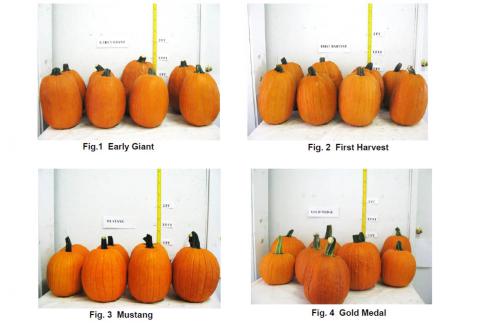Materials and Methods: New developments in disease resistance and market demand have increased the interest in growing pumpkins. New varieties of pumpkins with differing disease resistance packages are offered annually from numerous seed companies. This study was conducted to evaluate the yield of 16 cultivars of pumpkin grown in northern Mississippi in 2013 & 2014(Table1).
The experimental design was a randomized complete block with 4 replications. Each replication consisted of 10 plants. Plants were spaced 2 ft. apart in the row with rows on 12 ft. centers. Prior to bed formation fertilizer was broadcast, according to soil test recommendations, with all the P & K and ½ the N applied pre-plant. The remaining 40lb N per acre was applied by injecting, thru the drip tape, a concentrated solution of calcium nitrate(CaNO3) (5 lbs actual N/week) when vines began to“run”. Plants were direct seeded the 1st week in July and harvest began in mid-September.
The herbicide Strategy (ethalfluralin and clomazone) was applied immediately after seeding. One of the major diseases that infect pumpkins is powdery mildew, an airborne fungus that can cause extensive early defoliation, slow growth, and decrease yields. Powdery mildew developed and caused leaf defoliation even though a fungicide (chlorothalonil,azoxystrobin,orcopperhydroxide) was sprayed every 7-10 days.The varieties with powdery mildew resistance (PMR) had overall good yields and had the best disease ratings (Table1&2).
Results: ‘Mustang’ (Fig. 3) was one of the top producers with the best disease rating both years, and averaged 1.3 pumpkins per plant. ‘Early Giant’ (Fig. 1) was one of the biggest pumpkins both years but had a high disease rating and averaged 1.0 pumpkin per plant (Table 1 & 2). ‘Corvette’ (Fig. 10) was one of the best mid-size varieties, had one of the best disease ratings, and averaged 1.5 pumpkins per plant.‘Darling’ (Fig. 15) and ‘Early Abundance’ (Fig. 16) were two mid-size to small pie pumpkins that produced the most number per plant and had the least average weights with moderate to good disease resistance. The 2 new varieties trialed in 2014, ‘Jack-O-Lantern’ (Fig. 13) and P1-7606 (Fig. 14) , an unnamed experimental variety, both had high disease ratings and yielded moderately.

